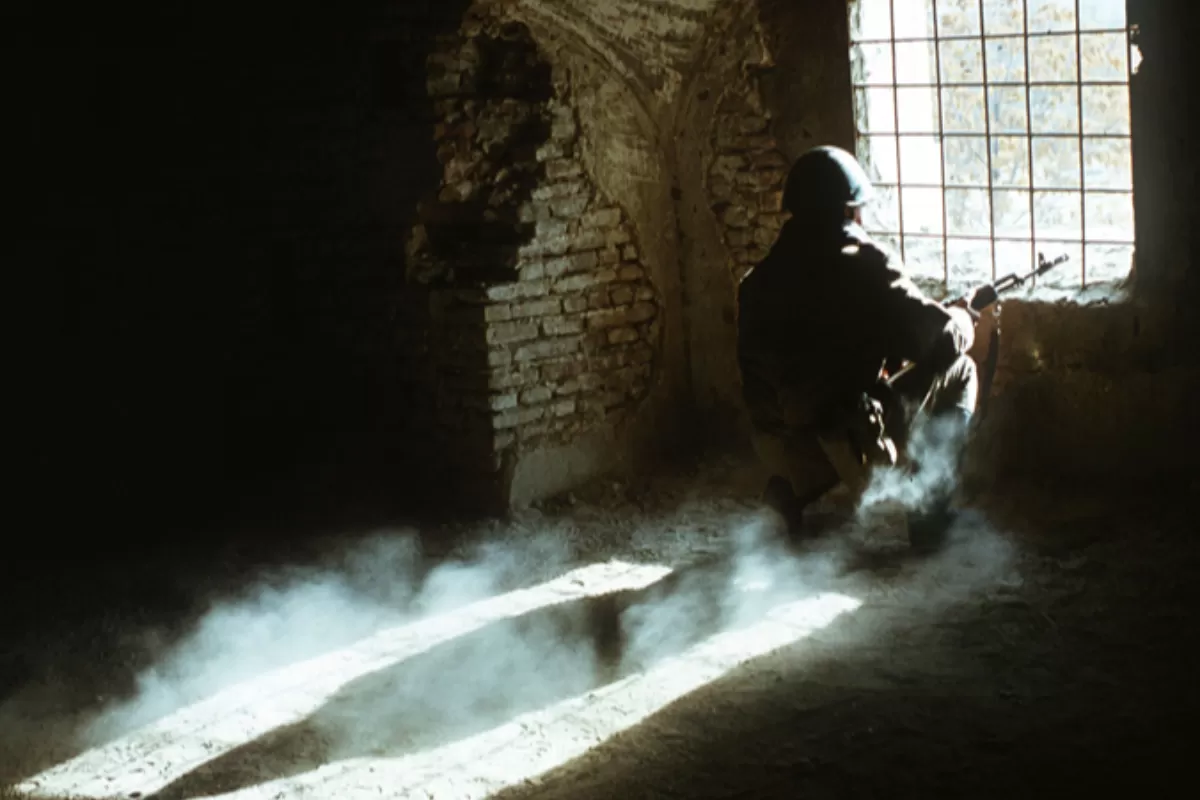
After the 2008 war in Georgia, the Russian officials promised to reform the army from the ground up, but today many army experts, as well as former Soviet Army soldiers, believe that the Russian war in Ukraine is based on tactics from three decades ago, except that the Russian army today relies on more sophisticated weapons.
Veridica.ro spoke with the historian and military researcher from Chisinau, Ion Xenofontov, to see what are the similarities and differences between the two wars waged by Russia. Xenofontov has a PhD degree in history from Babeș-Bolyai University in Cluj and is a military researcher at the “Alexandru cel Bun” Military Academy of the Armed Forces in Chisinau. He has written several books on the Soviet-Afghan war. The conflict had a significant impact on the former Moldavian Soviet Socialist Republic: more than ten thousand of its inhabitants fought in Afghanistan and more than three hundred lost their lives in that war.
Resemblances between the USSR’s war in Afghanistan and the Russian war against Ukraine
Veridica: What are the differences and resemblances between the war that Russia is waging today in Ukraine and the one fought by the late Soviet Union in Afghanistan, more than 30 years ago? Back then the USSR would sent 18-year-olds to the front; is the same happening with the war in Ukraine?
Ion Xenofontov: I see a lot of similarities between the Soviet-Afghan war, which was the most extensive in the Soviet period, lasting almost a decade, and the one started by Russia against Ukraine on February 24. Just like then, young people aged 18 to 19, with poor military skills, but also very poor ideological and motivational training, are being drafted.
However, during the Soviet era, young people would have been trained in patriotism in school. They were told about World War II, so at a subconscious level they were somehow prepared for a potential war.
As to the present moment, I believe that the Russian Federation has not prepared either its citizens or the young recruits for a possible escalation of the war in Ukraine.
This armed conflict is perceived by the general population of Russia as a war between Slavs. A fratricidal conflict. Today we see many images of young Russian soldiers being captured by Ukrainian military structures who look completely demoralized. They do not know where they really are and say that their superiors gave them false information about where they would be sent. All these are similarities with the war in Afghanistan, because even then there were young people in the USSR army who did not know, at least in the first phase of the war, in which country they had arrived and against whom they were supposed to fight.
Veridica: What did the architecture of the Soviet military system look like during the Russian invasion of Afghanistan?
Ion Xenofontov: The Soviet military system, compared to others from around the world, was very centralized. For example, the Soviet Ministry of the Interior also had a number of Republican branches. So did the KGB. But the Ministry of Defense of the Soviet Union never had republican ministries during the whole existence of the USSR. To them the army was an extremely powerful force and had to be kept strictly under Moscow's control.
Soviet Moldova was then part of the Soviet Union and was one of the 15 union republics within the USSR. So, Moldova fit into that general Union framework.
At first, the Soviets counted on the fact that the Asian republics in the USSR would somehow help carry out a swift military incursion into Afghanistan. But it was actually the other way around. Due to the language connection, communication bridges were created between Soviet soldiers from Tajikistan, Turkmenistan, Uzbekistan and the Afghan people. Some even had relatives in Afghanistan. And this is exactly what is happening today in the war between Russia and Ukraine.
Today, many Russian personalities come from mixed Russian-Ukrainian families, so it is a fratricidal war in the true sense of the word.
Youth from needy families, cannon fodder in war
Veridica: Who were the soldiers sent from the Moldavian Soviet Socialist Republic to fight on the Afghan front?
Ion Xenofontov: The vast majority of the Moldovan soldiers sent to Afghanistan came from the impoverished layers of society. The children of parents working in kolkhozes or industrial workers. They were soldiers with just high school education. We are not talking here about officers who had a military career and were better educated.
But ordinary soldiers would come from such poor backgrounds and, unfortunately, they were used as “cannon fodder”. We have to put it bluntly, because what has happened in the past has a lot to do with what is happening today.
These young people were a tool used by the political authorities back then and exposed to major risks that would threaten their health and life.
Veridica: In about 10 years of fighting in Afghanistan, between 1979 and 1989, how many Moldovans went to and how many returned from that war? Where exactly did they fight in Afghanistan and with what weapons?
Ion Xenofontov: Some 12,500 soldiers and civilians from the Moldavian Soviet Socialist Republic (MSSR) participated in the Soviet-Afghan war. Some did it to earn money, as auxiliary staff, such as cooks, psychologists, medical staff, etc.
Many Moldovan drivers went to Afghanistan. They were very good, thanks to the driving schools established in Soviet Moldova in the mid-1950s. They trained young people in technical driving and they were really good at it.
The second highly skilled category of Moldovans sent to Afghanistan were engineers. The best drivers and engineers in Afghanistan were Moldovan.
Officers in Afghanistan were mostly from the Slavic countries: Russians, Ukrainians, Belarusians. It should be noted that the Baltics didn’t really take part in this war. They somehow opposed the USSR's military interference in that country.
Officially, out of the total number of Moldovans who went to Afghanistan, 304 died. 301 names are inscribed on a monument dedicated to them in the Rascani sector of Chisinau, but during my research I found three more names. Then, because of the war, 700 of them became disabled and thousands of ex-combatants were left with psychological traumas after the war, and they are still suffering from related disorders.
I was talking to some of those who fought in the war and they told me than even now, after almost 40 years, they were still dreaming about military operations. They see people and houses on fire. They still suffer from the “eternal fighter” syndrome [post-traumatic stress disorder (PTSD)].
By the way, nobody in the Soviet Union would talk about “the war in Afghanistan”. This is a phrase we use today, but back then they would call it “the participation of the limited contingent of the 40th Army”.
Common narratives of Soviet and Russian propaganda in the wars in Afghanistan and Ukraine
Veridica: Today, Moscow calls it the “special operation” in Ukraine
Ion Xenofontov: Yes, that's right. In Afghanistan, they would say that the Soviet Union was providing “international aid” and that they were “defending the southern borders of the Soviet Union.” Nobody would official speak of war. So, some of the paradigms and stereotypes have been perpetuated up to the present day, and they are used to justify the Russian invasion of Ukraine.
Veridica: Did this myth of the “besieged city” work back then as well?
Ion Xenofontov: Yes, because Afghanistan was not part of the Soviet Union either. It was just on the southern border of the USSR. The Soviets operated in keeping with two main concepts: the so-called “international aid” and the “defense of the southern borders of the USSR.”
This Russian imperialism-based military paradigm has been used for centuries. The so-called enemy, an imaginary one after all, who threatens the security of the country has turned into a leitmotif. This myth is one of imperialist origin. All empires would create for themselves such security belts (glacis) away from their borders (buffer zone).
Even the members of the Warsaw Pact, Poland, Hungary, Romania, were somehow perceived as the Soviet Union’s fortification pillars. This is the paradigm that they have always used.
Veridica: How did the USSR behave after the Moldovan soldiers returned home. Were they helped by the system then?
Ion Xenofontov: There is a problem here. The USSR would collapse in 1991, and the war ended in 1989. Many experts say that one of the main causes of the collapse of the USSR was the war in Afghanistan. But there were a number of factors that ultimately led to this collapse.
It’s actually what always happens to empires, which collapse after several hundreds of years. So that was the pattern by which the Soviet Union dismantled too. The segment of ex-combatants in Afghanistan was associated with the Soviet state, so they were suddenly left without the logistical and ideological support that had previously sent them to fight there.
In 1991, the Republic of Moldova was trying to create its own identity. Emphasis was placed on other formulas, like the “new citizen”. So, the Afghanistan war veterans felt stigmatized and marginalized, benefiting from no public and social recognition. They were provided with no material support whatsoever.
When asking for material support, the bureaucrats would tell them: “I did not send you there.”


